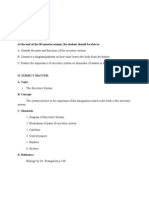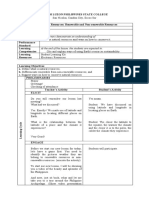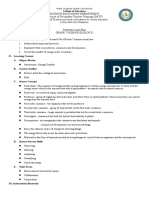Detailed Lesson Plan in Biology
Detailed Lesson Plan in Biology
Uploaded by
Jocel barnuevoCopyright:
Available Formats
Detailed Lesson Plan in Biology
Detailed Lesson Plan in Biology
Uploaded by
Jocel barnuevoOriginal Description:
Copyright
Available Formats
Share this document
Did you find this document useful?
Is this content inappropriate?
Copyright:
Available Formats
Detailed Lesson Plan in Biology
Detailed Lesson Plan in Biology
Uploaded by
Jocel barnuevoCopyright:
Available Formats
DON MARIANO MARCOS MEMORIAL STATE UNIVERSITY
North La Union Campus
Bacnotan, La Union
COLLEGE OF EDUCATION
Secondary Education Department
Detailed Lesson Plan
I. Objectives: At the end of the lesson, the students will be able to:
1. identify the different kinds of bacteria;
2. draw the different shapes of bacteria;
3. appreciate the benefits of bacteria.
II. Subject Matter:
A. Topic: Bacteria
B. Reference: a. Introduction to Bacteria.(April 19,2015).Retrieved
http://handsonclassrooms.org/files/Science/introduction_to_bact
eria_02.ppt
b. Bacteria - MicrobeWorld.(April 19,2015).Retrieved
from http://www.microbeworld.org/types-of-
microbes/bacteria
c. Bacteria -MicrobiologyOnline.(April19,2015).Retrieved
fromhttp://www.microbiologyonline.org.uk/about-
microbiology/introducing-microbes/bacteria
C. Materials: visual aids (mp and pictures)
D. Skills: drawing
E. Values: appreciation, patience
F. Concept: Bacteria are not all harmful to humans but rather, it
has more benefits to humans and the environment.
III.Procedure:
Teacher’s Activity Learner’s Activity
A. Preliminary Activities (take 5 mins)
Greetings
Prayers
Checking of Attendance
Classroom Management
B. Review (this will take 5 mins)
Before we proceed to our lesson, Ma’am bacteria and protozoa.
let’s have a review about
unicellular organism. Can you give
me an example of a unicellular
organism?
Ma’am, unicellular algae and
Very good, what else? unicellular fungi or yeasts.
Ma’am because they are single-celled
Yes. That’s correct! And why are organism. From the root word uni
they called unicellular organism? which means one or single.
Very good. These unicellular
organisms are single-celled and
also called prokaryotes. Now, do Ma’am Bacteria!
you have any idea if what is the
smallest type of unicellular
organism?
You’re right!
C. Motivation (this will take 10 mins)
Class, I have here a picture which
shows different words that are (students choose a word and explain)
related to bacteria. I want you to
choose one word and use it to
describe or define bacteria.
(show picture)
D. Developmental Activities
(this will take 20 mins)
Okay class, since we already
describe and define bacteria; let us
now study the different shapes of
Ma’am, the white colored bacterium
bacteria. Look at this photo
has a round shape.
carefully and tell me the shape of
each bacterium. (show picture)
Ma’am the bacterium on the center
Very good. What else?
has a rod shape.
Ma’am it is a spiral shaped bacterium.
Correct. And the last one?
Yes. Very good. These are the
three basic shapes; rod shaped
called bacilli, round shaped called
cocci and the spiral shaped also
called spirillum. Some exist as
single cells, others are clustered
together.
Yes ma’am!
Do you think bacteria are alive?
Ma’am because the bacteria can
Why do you think so?
reproduce.
Ma’am because they eat.
You’re right. Very good! What else
can make you think that a
bacterium is alive?
Ma’am because the bacteria can
Yes. What else? move.
Ma’am they use their flagella to move.
Very good. What do they use to
move?
Yes. Most motile bacteria move by
the use of flagella There are helical
bacteria which have a specialized
internal structure known as the
axial filament which is responsible
for rotation of the cell in a spiral
fashion and consequent
locomotion and others are gliding
bacteria. Ma’am they reproduce through binary
fission wherein they multiply through
Since we said a while ago that a division.
bacteria can reproduce, do you
have any idea how they Ma’am through conjugation, wherein
reproduce? the cilia of the bacterium connects to
other cilia of a bacterium then
Very good. There is one more way transfers genetic material to another.
on how bacteria reproduce, what is
it? Ma’am some make their own food
from sunlight, like the photosynthetic
bacteria.
You’re right! Now, what do you
think do they eat? Ma’am some are scavengers like the
bacteria in our stomach which eat
what we eat.
Yes. Another?
Ma’am some bacteria eat other
bacteria which are also called
pathogens.
Correct! What else?
Ma’am bacteria that make us sick.
Very good! So what are Ma’am they produce poisons that
pathogens? Do you have any result in fever, headache, vomiting,
idea? and diarrhea and destroy body tissue.
And how do they make you sick? Ma’am through direct contact with
people who are sick.
Ma’am from food, Water, or other
Correct! Where do you get a surfaces that are contaminated.
pathogen?
Yes ma’am. For example, you could
Yes, what else? become infected if you come into
contact with equipment that has
been touched by an ill person.
Is it also possible that you get
infected through indirect contact? Ma’am some pathogenic bacteria rely
How? on insect carriers such as
mosquitoes, fleas, lice or ticks to
move from host to host.
No ma’am.
Yes. What else?
Ma’am not all bacteria are pathogenic
because there are some types of
bacteria that help with digestion and
Very good! Are all bacteria also used as ingredients of some
pathogens? foods like cheese for fermentation.
Why? Explain further. Ma’am it is also used for production of
antibiotics and the photosynthetic
bacteria produces oxygen.
Correct. Anymore more idea?
Ma’am, one is Pediococcus which is
used in production of fermented
meats.
Very well said! Can you give some
example of helpful bacteria as we
have said a while ago that not all Ma’am Lactobacillus casei which is
bacteria are pathogenic and some found in human intestines and mouth
are helpful? So what are these to improve digestion.
helpful bacteria?
Ma’am Leuconostoc cremoris which is
Yes. What else? used in the production of buttermilk
and sour cream.
Ma’am Lactobacillus bulgaricus which
Anymore? is used in the production of yogurt
and cheese.
Ma’am Pathogenic E. coli which is
No more? found in ground beef, contaminated
fruits and vegetables.
Ma’am Salmonella which is found in
Very good. Do you know some raw meats, poultry, eggs, sprouts, fruit
common pathogens? and vegetables
Ma’am Listeria which is Found in deli
Yes. What else? foods, lunch meats, smoked fish and
vegetables.
Ma’am washing our hands often will
Correct. What else? avoid the transfer of bacteria to our
mouth or food.
You’re right. So what can we do to Ma’am food should be cook
prevent or avoid these pathogenic thoroughly to kill any pathogens that
bacteria? may be in the food.
Yes. What else? Ma’am let us store food properly to
limit pathogen growth.
Correct. Anymore?
Very good!
(students will now draw)
E. Application (this will take 5 mins)
Direction: Bring out a piece of bond
paper and draw the different
shapes of bacteria. Ma’am bacteria are the smallest
unicellular organism.
F. Generalization (this will take 5 mins)
Okay class, let’s have a recap on Ma’am the rod shaped called bacilli,
what we have discussed today. round shaped called cocci and the
What are bacteria? spiral shaped also called spirillum.
What are the different shapes of Ma’am they move, reproduce and eat.
bacteria?
Ma’am the bacteria that make us sick.
What are the evidences or proof
that bacteria are alive? Ma’am through direct and indirect
contact with other people. And also
What are pathogens? from the contaminated foods, water
and surfaces.
How do we get pathogens?
Ma’am Pediococcus which is used in
production of fermented meats,
Lactobacillus casei which is found in
human intestines and mouth to
What are the examples of good improve digestion, Leuconostoc
bacteria? cremoris which is used in the
production of buttermilk and sour
cream and Lactobacillus bulgaricus
which is used in the production of
yogurt and cheese.
Ma’am Pathogenic E. coli which is
found in ground beef, contaminated
fruits and vegetables, Salmonella
which is found in raw meats, poultry,
What are the common pathogenic eggs, sprouts, fruit and vegetables
bacteria? and Listeria which is Found in deli
foods, lunch meats, smoked fish and
vegetables.
Ma’am we should wash our hands
often, food should be cook thoroughly
and food should be stored properly to
avoid pathogenic bacteria.
How can we avoid pathogenic
bacteria?
Very good!
IV. Evaluation (this will take 5 mins)
Direction: Bring out ¼ piece of paper and identify the following bacteria if it is
beneficial or harmful and give their shape. (14 pts.)
1. Pediococcus
2. Pathogenic E. coli
3. Lactobacillus casei
4. Salmonella
5. Leuconostoc cremoris
6. Listeria
7. Lactobacillus bulgaricus
V. Assignment
Read about multicellular organism.
Prepared by:
Sharon M. Ballasiw
BSE II- BioSci
Presented to:
Dr. Violeta F. Collado
Course Instructor
Photo used in Motivation:
Photo used in the developmental activity: Identification of shapes.
You might also like
- Trade Agarwood Japan PDFDocument21 pagesTrade Agarwood Japan PDFRabindranath Hendy TagoreNo ratings yet
- Detailed Lesson Plan About BacteriaDocument7 pagesDetailed Lesson Plan About BacteriaLexter Gabica100% (3)
- Detailed Lesson Plan in BiologyDocument7 pagesDetailed Lesson Plan in BiologyZam Loredo100% (3)
- Detailed Lesson Plan (ABUZO and FRANCISCO)Document6 pagesDetailed Lesson Plan (ABUZO and FRANCISCO)Abigail Chang100% (1)
- Lesson Plan Science Yr8 Asexual ReproductionDocument3 pagesLesson Plan Science Yr8 Asexual Reproductionapi-26179694067% (3)
- Lesson Plan 5eDocument3 pagesLesson Plan 5eapi-324014008100% (3)
- 010 Monograph Bacopa MonnieraDocument4 pages010 Monograph Bacopa MonnieraMSKCNo ratings yet
- Ethics Case StudyDocument9 pagesEthics Case Studyapi-305128971100% (1)
- DUTy ReflectionDocument3 pagesDUTy Reflectionrose angela100% (1)
- Detailed Lesson PlanDocument7 pagesDetailed Lesson PlanClinton SabioNo ratings yet
- Detailed Lesson Plan in BiologyDocument7 pagesDetailed Lesson Plan in BiologyElma Grace Sales-DalidaNo ratings yet
- DLP FungiDocument6 pagesDLP FungiVia German BorilloNo ratings yet
- Bacteria Lesson PlanDocument11 pagesBacteria Lesson PlanFrancis Kevin Mag-usaraNo ratings yet
- Lesson Plan For Science 7 - BacteriaDocument6 pagesLesson Plan For Science 7 - BacteriaAster May Catulong0% (1)
- Detailed Lesson Plan in Biology1Document5 pagesDetailed Lesson Plan in Biology1Ian Culi50% (2)
- Lesson Plan Science Demo Junior HighDocument4 pagesLesson Plan Science Demo Junior HighDotecho Jzo Ey100% (1)
- Lesson Plan 7 FungiDocument4 pagesLesson Plan 7 FungiLarraine Bernice Gannaban Cabildo100% (9)
- Lesson Plan in Phylum Protozoa G8Document4 pagesLesson Plan in Phylum Protozoa G8Jeanacela PagaspasNo ratings yet
- Semi Detailed Lesson Plan in ScienceDocument6 pagesSemi Detailed Lesson Plan in ScienceJoshua Dela CruzNo ratings yet
- A Detailed Lesson Plan in BiochemistryDocument8 pagesA Detailed Lesson Plan in BiochemistryMusa BuwatNo ratings yet
- A Detailed Lesson Plan in Science For Grade TenDocument10 pagesA Detailed Lesson Plan in Science For Grade Tenliamacaorog98No ratings yet
- Lesson Plan in ScienceDocument5 pagesLesson Plan in ScienceJESPHER GARCIANo ratings yet
- A DETAILED LESSON PLAN FOR GRADE VII 4as - GarzonDocument8 pagesA DETAILED LESSON PLAN FOR GRADE VII 4as - GarzonKresha LluismaNo ratings yet
- Lesson Plan in Science I. ObjectivesDocument6 pagesLesson Plan in Science I. Objectiveskirsty jane rodriguezNo ratings yet
- Detailed - Lessonplan-Energy ResourcesDocument11 pagesDetailed - Lessonplan-Energy Resourcesrhealyn jaramillaNo ratings yet
- A Detailed Lesson Plan in Science 9Document6 pagesA Detailed Lesson Plan in Science 9Alexis Dale DiazNo ratings yet
- Detailed Lesson Plan in Science (Biology)Document1 pageDetailed Lesson Plan in Science (Biology)Bithao Daisy100% (2)
- Detailed Lesson Plan in Science ViDocument5 pagesDetailed Lesson Plan in Science ViBenazir FuadNo ratings yet
- LESSON PLAN Protista FixDocument13 pagesLESSON PLAN Protista FixRizki Armando Putra100% (1)
- States of Matter ActivitiesDocument5 pagesStates of Matter ActivitiesPoy AlisNo ratings yet
- Lesson Plan For Print - Science and Health 6Document10 pagesLesson Plan For Print - Science and Health 6Aldrin Paguirigan100% (1)
- Semi-Detailed Lesson PlanDocument3 pagesSemi-Detailed Lesson PlanVismay Mona AttarNo ratings yet
- A Detailed Lesson Plan in Biology IIDocument5 pagesA Detailed Lesson Plan in Biology IIJohn Daniel LabadiaNo ratings yet
- (Template) Activity 2Document2 pages(Template) Activity 2ken dexter m. barrera100% (1)
- Circulatory System Lesson Plan 1Document3 pagesCirculatory System Lesson Plan 1api-282832608No ratings yet
- Detailed Lesson PlanDocument9 pagesDetailed Lesson PlanJoyce JenkinsNo ratings yet
- Lesson Plan CellsDocument7 pagesLesson Plan CellsNemcris Mae OpleNo ratings yet
- DLP 1Document2 pagesDLP 1Marlou ArizalaNo ratings yet
- Detailed Lesson in BIOLOGYDocument3 pagesDetailed Lesson in BIOLOGYJamie anne Hernandez0% (1)
- Detailed Lesson Plan Grade 10 Science I. Lesson ObjectivesDocument7 pagesDetailed Lesson Plan Grade 10 Science I. Lesson ObjectivesRobelyn CamerosNo ratings yet
- Unit 1 Ecology Performance Task CerDocument3 pagesUnit 1 Ecology Performance Task Cerapi-534779290100% (1)
- Basic 7e Lesson Plan in BiologyDocument6 pagesBasic 7e Lesson Plan in Biologygerlyn muringNo ratings yet
- Energy Transfer DLPDocument4 pagesEnergy Transfer DLPLouise Meara SeveroNo ratings yet
- Lesson PlanDocument4 pagesLesson PlanAbdul WahabNo ratings yet
- Characteristics of LivingThings Lesson Plan ScienceDocument1 pageCharacteristics of LivingThings Lesson Plan ScienceRANJITA50% (2)
- Detailed Lesson Plan FormatDocument6 pagesDetailed Lesson Plan FormatMarylyn TabaquiraoNo ratings yet
- Detailed Lesson Plan in ScienceDocument4 pagesDetailed Lesson Plan in ScienceWilliam Michael Marikit Santia Jr.No ratings yet
- Sample Lesson Plan ScienceDocument6 pagesSample Lesson Plan ScienceJochel AlingagNo ratings yet
- Lesson Plan 3Document7 pagesLesson Plan 3trexia autidaNo ratings yet
- Cell - The Basic Unit of Life: 2.2 Understanding Unicellular and Multicellular OrganismsDocument14 pagesCell - The Basic Unit of Life: 2.2 Understanding Unicellular and Multicellular OrganismsSakenah Yehya Syed NoordinNo ratings yet
- DETAILED LESSON PLAN in EARTH SCIENCE GRDocument4 pagesDETAILED LESSON PLAN in EARTH SCIENCE GRRomeo Gabitanan Jr50% (2)
- Learning Objectives: Learning Competencies Set by Deped S7Lt-Iih-10 - Differentiate The DifferentDocument4 pagesLearning Objectives: Learning Competencies Set by Deped S7Lt-Iih-10 - Differentiate The DifferentCassy Joy Ellopo RellamaNo ratings yet
- MicroorganismsDocument10 pagesMicroorganismsLouie Jane EleccionNo ratings yet
- Semi-Detailed Lesson Plan (Sanchez)Document3 pagesSemi-Detailed Lesson Plan (Sanchez)Wiljoyce SanchezNo ratings yet
- A Detailed Lesson Plan in Science 9 I. ObjectivesDocument7 pagesA Detailed Lesson Plan in Science 9 I. ObjectivesShiela Mae OsmanNo ratings yet
- Detailed Lesson Plan in ScienceDocument6 pagesDetailed Lesson Plan in SciencePeaby Lopez Bontuyan100% (4)
- 5 Visualizing The Nitrogen CycleDocument6 pages5 Visualizing The Nitrogen CycleEdnalyn Licot0% (1)
- A Detailed Lesson Plan Ecololy Sci 2Document9 pagesA Detailed Lesson Plan Ecololy Sci 2AlezandraNo ratings yet
- S7Lt - Iig - 7 (7.1) S7Lt - Iig - 7 (7.2) : Week 5Document1 pageS7Lt - Iig - 7 (7.1) S7Lt - Iig - 7 (7.2) : Week 5Gen Dee100% (1)
- Daily Lesson Log: Types-Of-Biodiversity/30141Document7 pagesDaily Lesson Log: Types-Of-Biodiversity/30141Noreenzel Joy VillanuevaNo ratings yet
- A Semi - Detailed Lesson PlanDocument3 pagesA Semi - Detailed Lesson PlanCelyn MillanoNo ratings yet
- Adaptations and Survival Lesson PlanDocument4 pagesAdaptations and Survival Lesson Planapi-339651962No ratings yet
- A Detailed Lesson Plan in Science 10 (The Endocrine System)Document8 pagesA Detailed Lesson Plan in Science 10 (The Endocrine System)Renz CruzNo ratings yet
- Detailed Lesson Plan in BiologyDocument7 pagesDetailed Lesson Plan in BiologyMavie Golim ValenciaNo ratings yet
- Review of LiteratureDocument31 pagesReview of LiteratureJocel barnuevoNo ratings yet
- Ma Tte R: Mi XT Ur Es Pu Re Su BST An Ce SDocument46 pagesMa Tte R: Mi XT Ur Es Pu Re Su BST An Ce SJocel barnuevoNo ratings yet
- Food ChainDocument13 pagesFood ChainJocel barnuevoNo ratings yet
- Lesson Overview: 5E Lesson Plan ModelDocument8 pagesLesson Overview: 5E Lesson Plan ModelJocel barnuevoNo ratings yet
- Skripsi Tanpa Bab Pembahasan PDFDocument63 pagesSkripsi Tanpa Bab Pembahasan PDFYogi PradanaNo ratings yet
- Ga One LinerDocument3 pagesGa One LinerPadmavathi CNo ratings yet
- Soal CampbellDocument5 pagesSoal CampbellAdryansyah ChaniagoNo ratings yet
- Cerebrospinal Fluid Rhinorrhea: Diagnosis and Management: Julie T. Kerr, MD, Felix W.K. Chu, MD, Stephen W. Bayles, MDDocument15 pagesCerebrospinal Fluid Rhinorrhea: Diagnosis and Management: Julie T. Kerr, MD, Felix W.K. Chu, MD, Stephen W. Bayles, MDapasic9833No ratings yet
- Bahagian ADocument22 pagesBahagian AWan HaziqNo ratings yet
- A Repertory of Homoeopathic Nosodes Sarcodes Berkeley Squire.07642 - 1contents - Preface - Introduction - LayoutDocument6 pagesA Repertory of Homoeopathic Nosodes Sarcodes Berkeley Squire.07642 - 1contents - Preface - Introduction - Layoutinnahifi111No ratings yet
- The Effect of Additional Ankle and Midfoot Mobilizations On Plantar Fasciitis: A Randomized Controlled TrialDocument11 pagesThe Effect of Additional Ankle and Midfoot Mobilizations On Plantar Fasciitis: A Randomized Controlled Trialrizk86No ratings yet
- How To Apply ICF in Rehabilitation PDFDocument14 pagesHow To Apply ICF in Rehabilitation PDFCyndi MenesesNo ratings yet
- GuidelinesDocument8 pagesGuidelinesChandan ShahNo ratings yet
- CpapDocument33 pagesCpapAtikah Putri AtmojoNo ratings yet
- Foeniculum Vulgare Assessment ReportDocument23 pagesFoeniculum Vulgare Assessment ReportRamya MCNo ratings yet
- SerratiopeptidaseDocument4 pagesSerratiopeptidaseMo KhanNo ratings yet
- Saudi Journal of Biological SciencesDocument5 pagesSaudi Journal of Biological SciencesnabilaNo ratings yet
- Adverb of Place and TimeDocument3 pagesAdverb of Place and TimeCherry Mae SanchezNo ratings yet
- Approach To The Patient With DyspneaDocument22 pagesApproach To The Patient With DyspneaLuis Gerardo Alcalá GonzálezNo ratings yet
- Acknowledgement, Intro, Profile, Directory, Economic ProposalDocument34 pagesAcknowledgement, Intro, Profile, Directory, Economic ProposalMelody Kaye MonsantoNo ratings yet
- CardioSoft Specifications TenderDocument4 pagesCardioSoft Specifications TenderChris HartoyoNo ratings yet
- Nursing DiagnosisDocument6 pagesNursing DiagnosisFhai Escio100% (1)
- Materia Medica PuraDocument224 pagesMateria Medica PuraMorgan CabreraNo ratings yet
- Isi BukuDocument183 pagesIsi BukuHayat Hamzah DawiNo ratings yet
- Coursework For Pharmacy TechnicianDocument7 pagesCoursework For Pharmacy Technicianpenebef0kyh3100% (2)
- Cefalexin - Wikipedia, The Free EncyclopediaDocument3 pagesCefalexin - Wikipedia, The Free EncyclopediajhgkhgkhgNo ratings yet
- Bioorganic & Medicinal Chemistry Letters: Shaoyi Sun, Qi Jia, Zaihui Zhang TDocument16 pagesBioorganic & Medicinal Chemistry Letters: Shaoyi Sun, Qi Jia, Zaihui Zhang TjulianaNo ratings yet
- Students August SeminarDocument12 pagesStudents August SeminarjjjkkNo ratings yet
- PG Rotation Overview 2009Document3 pagesPG Rotation Overview 2009bestgraNo ratings yet
- 7 Rights of Medication Administration For NursesDocument3 pages7 Rights of Medication Administration For NursesOhenewaa RitaNo ratings yet





























































































